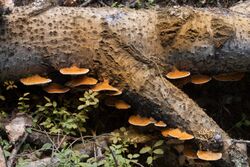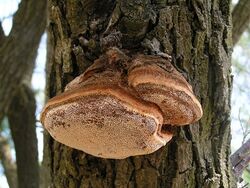Biology:Inocutis
| Inocutis | |
|---|---|

| |
| Inocutis rheades | |
| Scientific classification | |
| Kingdom: | |
| Division: | |
| Class: | |
| Order: | |
| Family: | |
| Genus: | Inocutis Fiasson & Niemelä (1984)
|
| Type species | |
| Inocutis rheades (Pers.) Fiasson & Niemelä (1984)
| |
Inocutis is a genus of nine species of polypore fungi in the family Hymenochaetaceae.
Taxonomy
The genus was circumscribed by Jean-Louis Fiasson and Tuomo Niemeläin 1984 as a segregate genus from Inonotus. They originally included three European species formerly placed in Inonotus section Phymatopilus,[1] a grouping of species conceived by Marinus Anton Donk in 1974.[2] Molecular data later supported the genus concept.[3][4][5] Inocutis is phylogenetically close to Fomitiporella.[4]
Description
Inocutis species produce annual fruit bodies. They are characterized by the absence of setae, the presence of a rudimentary granular core, and the presence of sclerified hyphae in the granular core. They have yellowish to brownish spores that are ellipsoid in shape, and non-dextrinoid. The hyphal system is monomitic, consisting of only generative hyphae. They all grow on deciduous substrates.[4]
Species
- Inocutis dryophila (Berk.) Fiasson & Niemelä 1984[1]
- Inocutis jamaicensis (Murrill) A.M.Gottlieb, J.E.Wright & Moncalvo 2002 – North America; South America[5]
- Inocutis levis (P.Karst.) Y.C.Dai 2000 – China[6]
- Inocutis ludoviciana (Pat.) T.Wagner & M.Fisch. 2002[4]
- Inocutis porrecta (Murrill) Baltazar 2010[7]
- Inocutis rheades (Pers.) Fiasson & Niemelä 1984 – Europe;[1] Middle East[8]
- Inocutis subdryophila Y.C.Dai & H.S.Yuan 2005 – China[9]
- Inocutis tamaricis (Pat.) Fiasson & Niemelä 1984[1] – Africa; Asia; Europe; Middle East[10]
- Inocutis texana (Murrill) S.Martínez 2006 – North America; South America[11]
References
- ↑ 1.0 1.1 1.2 1.3 "The Hymenochaetales: a revision of the European poroid taxa". Karstenia 24 (1): 14–28. 1984.
- ↑ Donk MA. (1974). Checklist of European Polypores. Verhandelingen der Koninklijke Nederlandse Akademie van Wetenschappen, Afd. Natuurkunde. Tweede Reeks. 62. Amsterdam; London: North Holland Publishing Company.
- ↑ "Natural groups and a revised system for the European poroid Hymenochaetales (Basidiomycota) supported by nLSU rDNA sequence data". Mycological Research 105: 773–782. 2001. doi:10.1017/s0953756201004257.
- ↑ 4.0 4.1 4.2 4.3 "Proceedings towards a natural classification of the worldwide taxa Phellinus s.l. and Inonotus s.l., and phylogenetic relationships of allied genera". Mycologia 94 (6): 998–1016. 2002. doi:10.2307/3761866. PMID 21156572.

- ↑ 5.0 5.1 "Inonotus s. l. in Argentina – morphology, cultural characters and molecular analyses". Mycological Progress 1 (3): 299–313. 2002. doi:10.1007/s11557-006-0028-5.
- ↑ Dai YC. (2000). "A checklist of polypores from Northeast China". Karstenia 40: 23–39.
- ↑ "Inonotus s.l. (Hymenochaetales) in the Brazilian herbaria FLOR and SP". Sydowia 62 (1): 1–9. 2010.
- ↑ "The genus Inonotus sensu lato in Iran, with keys to Inocutis and Mensularia worldwide". Annales Botanici Fennici 45: 465–476. 2008. doi:10.5735/085.045.0605. http://www.sekj.org/PDF/anbf45/anbf45-465.pdf.
- ↑ "Inocutis subdryophila (Basidiomycota), a new polypore from China". Mycotaxon 93: 167–171. 2005.
- ↑ Piątek M. (2001). "Inonotus tamaricis (Fungi, Hymenochaetales) on Melos in Greece". Polish Botanical Journal 46 (2): 275–277. http://bomax.botany.pl/pubs/data/article_pdf?id=752.
- ↑ Martinez S. (2006). "The genera Inocutis and Inonotus (Hymenochaetales) in Uruguay". Mycotaxon 96: 1–8. http://www.cybertruffle.org.uk/cyberliber/59575/0096/0001.htm.
Wikidata ☰ Q10535741 entry
 |


